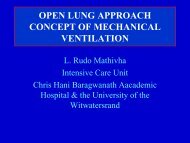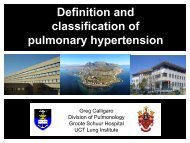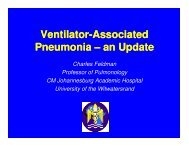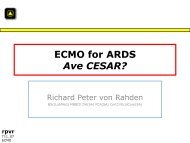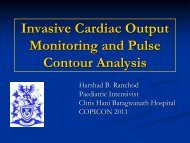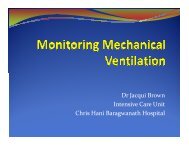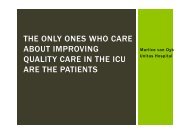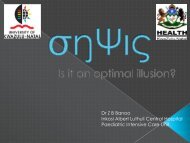Florian Von GrooteBidlingmaier Staging including PET scanning
Florian Von GrooteBidlingmaier Staging including PET scanning
Florian Von GrooteBidlingmaier Staging including PET scanning
- No tags were found...
Create successful ePaper yourself
Turn your PDF publications into a flip-book with our unique Google optimized e-Paper software.
<strong>Staging</strong> of Lung Cancer<strong>Florian</strong> von Groote-BidlingmaierDivision of PulmonologyStellenbosch University29 August 2012
Overview• 7 th edition of the TNM staging system• Clinical <strong>Staging</strong>• Radiological <strong>Staging</strong>• Integrated <strong>PET</strong>/CT
SurvivalGoldstraw et al, J Thorac Oncol 2007
IAIBIIAIIBTherapy_____________________________________________IIIA_____________________________________________IIIBIVSurgeryChemo/Radiotherapy
7 th Edition of the TNM <strong>Staging</strong> System(as of Jan 2010)Detterbeck et al, Chest 2009
In a nutshell - What has changed?T4N0-1Pleural effusionNodules in same lobeNodules in other ipsilateral lobeIIIAM1aT3T4New size cut-offsNew subdivisions (T1a, T1b; T2a, T2b; M1a, M1b)
Approach to staging• History and physical• Lab testing,• Standard radiology (CXR, CT Chest)• Additional imaging• Tissue sampling• Establish the highest disease stage• Stage according to TNM system
General health status, pulmonarySystemic symptoms• Weight loss• Anorexia• Fatigue• Fever• Depressionhealth status
New or worsening dyspneaMalignant effusion (M1a disease)
Bone painBone metastases (M1b disease)
DysphagiaBulky mediastinal disease (N2 or N3) or esophagealinvasion (T4)
Neurologic abnormalitiesHeadaches, syncope, weakness, cognitive impairmentdue to brain metastases (M1b)
Horner’s syndromeInvasion of last cervical or first thoracic segment of thesympathetic trunk (T4)
HoarsenessLeft recurrent laryngeal nerve (T4, N2 or N3)
SVC syndromeCompression or invasion of superior vena cava (T4, N2,N3), often small cell carcinoma
Pericardial tamponadePericardial invasion (T4)Malignant pericardial effusion (M1a)
Enlarged LNs (supraclav, scalene)LN metastases (N3)
HepatomegalyHepatic metastases (M1b)
Paraneoplastic syndromesNot necessarily due to metastatic diseasePresence does not obviate complete staging!
Chest radiograph- Readily available- Inexpensive- Comparison to prior radiographs- 0.02 mSv for pa image
UltrasoundChest wall invasion of lung masses (at least T3)Lymph nodes (N3 or M1b disease)Pleural effusion (M1a)Liver metastases (M1b)
CT ScanTumor (T-<strong>Staging</strong>)- Tumor size- Presence/absence of separatetumor nodules- Obstructive pneumonitis- Invasion of adjacent structures
CT ScanLymph nodes (N-<strong>Staging</strong>)- Measured in short axis, normal < 10cm- Subcarinal lymph nodes can be normal up to 15 cm- Nodes exceeding these sizes are more likely to bemalignant in patients with lung cancer, but metastaticdisease can exist in normal sized lymph nodes and largerlymph nodes can be benign
CT ScanNode sizeMalignant
CT ScanLymph nodes (N-<strong>Staging</strong>)Meta-analysis of 35 studies (5111 pts):Sensitivity 51%, specificity 86% in a population with aprevalence of 28%Tissue sampling is required!Silvestri et al, Chest 2007
Metastases (M-<strong>Staging</strong>)CT ScanAssignment of M1a or M1b disease on the basis of CTshould be considered tentativeBrain mets: sens 76%, spec 82%Liver and adrenal: UncertainTissue sampling is required!Silvestri et al, Chest 2007
Integrated <strong>PET</strong>/CT=Anatomical information+metabolic information
1998: First integrated <strong>PET</strong>/CT scanner2012: <strong>PET</strong>/CT scanner at TygerbergBeyer T, et al. J Nucl Med 2000
Combination of anatomical and metabolic information18 Fluoro-Deoxy-Glucose used as tracer
Integrated <strong>PET</strong>-CT+=
SUV – standardized uptake valueSUV= R/(d/V)R= activity concentration within ROId= decay-corrected injected doseV= surrogate for the volume of distribution of tracerinside the body
T-StageDe Wever et al., ERJ 2009
Integrated <strong>PET</strong>/CT is superior to CT alone, <strong>PET</strong> alone,and <strong>PET</strong> and CT images viewed side by sideLardinois et al, NEJM 2003
N-StageDe Wever et al., ERJ 2009
High Negative Predictive Value(>90%)
SUV threshold of 2.5 resulting in high NPV (96%) allowsomission of mediastinoscopy in patients with negative18F-FDG <strong>PET</strong>Hellwig et al, JNM 2007
M-StageBest noninvasive imaging technique in evaluatingdistant metastases<strong>PET</strong>/CT predicts metastatic disease better than<strong>PET</strong> alone (92% vs. 87%)Bone 100% vs. 86%Liver 100% vs. 100%Adrenals 66% vs. 66%GI 100% vs. 50%Lardinois et al, NEJM 2003Cerfolio et al. Ann Thorac Surg 2004
Unexpected ETM 13/94 patients (14%)Upstaged to N3 6/94 patients (6%)_____________________________________Understaged20% of patientsWeder et al, Ann Thorac Surg 1998
189 patients randomly assigned to either conventionalstaging + integrated <strong>PET</strong>/CT or conventional stagingaloneFischer et al, NEJM 2009
• Number of totalthoracotomies and number offutile thoracotomies reduced(M-<strong>Staging</strong>)• No effect on mortalityFischer et al, NEJM 2009
• Best non-invasive technique topredict T-Stage• High NPV in N-<strong>Staging</strong>, but positivefindings have to be confirmed• Most important additional value is M-<strong>Staging</strong>
• False positives and false negatives• Quality of CT often not ideal• Availability
“Tissue is the Issue”
EBUS TBNA significantly better than conventional TBNAin LN stations except subcarinal (84% vs. 58%, p
SensitivityMediastinoscopy 79%EBUS/EUS 85%EBUS/EUS followed by mediastinoscopy 94%Annema et al, JAMA 2010
What if the mediastinum is <strong>PET</strong>negative?97 patients with NSCLC underwent EBUS-TBNA, aver. LNsize 0.7cmPos LN in 8%Herth et al, Chest 2008
Summary• Correct staging is important for prognosisand therapy• Standard Imaging incl. <strong>PET</strong>-CT• Tissue is the issue!• Use combined methods depending onavailability and local expertise
Thank you!



